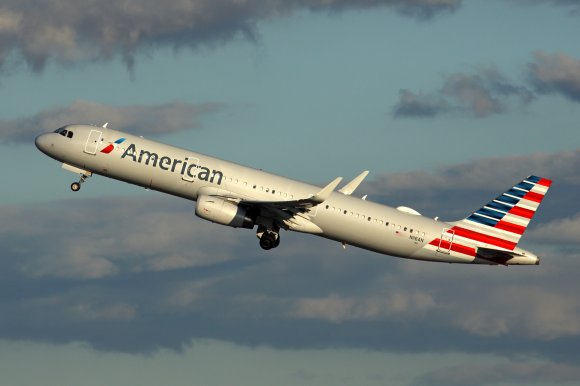Why did an American Airlines A321 taking off sustaining serious damage?

A departing American Airlines A321 veered to the left, rolled and hit a runway sign with its left wingtip, sustaining serious damage. Why?
It happened on the 10th of April 2019, at JFK. And it was serious enough that the aircraft in question never flew again. The NTSB recently released its docket about this accident, along with some interesting information. The crew of this American Airlines A321 were performing flight AA-300. It is a daily evening service from New York’s John F. Kennedy International (KJFK) to Los Angeles International (KLAX).
The flight crew lined up with JFK’s runway 31L for departure. They were on time, commencing their take-off roll at about 8:40 pm local time. But as it accelerated, it appears that the aircraft began to veer left. Plus, it began rolling to the left. It would later emerge that the American Airlines A321 was dragging its wingtip along the ground for a considerable distance.
Along the way, the aircraft hit a runway sign (distance marker) and an airport light, according to the FAA. Thankfully, the crew was then able to lift off and climb normally. The flight’s Captain, who was pilot-flying, then felt that the aircraft was behaving normally. But eventually, the crew decided to return to JFK. Sometime after this decision, a cabin crew member informed the pilots that the left wing had suffered some damage.
The American Airlines crew landed their A321 safely on runway 04L, approximately half an hour after departure. They then taxied to a stand, where ground crews quickly confirmed that the aircraft had suffered serious damage. The 101 passengers and 8 crew didn’t suffer any injuries. Another A321 would take the passengers to LAX, with a 13-hour delay.
When it arrives, the NTSB’s final report will confirm the reasons behind this accident. But the Board released some more information in its docket. One detail relates to changes in some procedures:
“The flightcrew stated that American Airlines had recently created new flows for the pushback and taxi phases of flight. The captain reported that during pushback he queried the FO about the trim settings to which the FO reported that those were to be done later, according to the latest guidance by the airline.”
Also, as they lined up their A321 for departure, the American Airlines crew observed that the wind was stronger than they expected. But the two pilots agreed that they were well within limits for departure. Then during the takeoff roll, the Captain recalled that applying left rudder, to counter the right crosswind, seemed different, requiring more force. However, the aircraft felt “OK” at 80 knots.
V1 was 150 knots, and Vr was 156. Between these speeds, the aircraft began to turn left, requiring right rudder. The Captain stated that he had to rotate, to keep the aircraft away from the runway edge. But upon rotation, the aircraft began to roll to the left. Looking up after announcing “Rotate”, the First Officer saw the unusual attitude and began making control inputs. With both pilots now applying back pressure on their sidesticks, the aircraft lifted off.
The accident aircraft was an A321-231(WL), with registration N114NN, that American Airlines began operating in April 2014. It was just five years old at the time. After remaining on the ground at JFK for over 20 months, the unlucky jet was scrapped, in January 2021. mentourpilot.com
